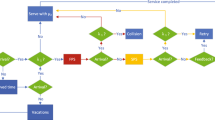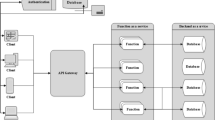Abstract
Nowadays, video-on-demand (VoD) providers offer multiple-quality video streaming services to users, called as multi-version VoD. Unlike traditional VoD, multi-version VoD providers should consider to allocate bandwidth resource and transcoding computation resource simultaneously. However, most of existing resource allocation works only focused on cost reduction or bandwidth optimization, and they did not consider to allocate transcoding computation resources for multi-version VoD systems. Therefore, how to allocate bandwidth resource and transcoding computation resource simultaneously for multi-version VoD systems is still one major challenge. In this paper, we propose a queue-based and learning-based dynamic resources allocation strategy (QLRA) for virtual streaming media server cluster of multi-version VoD system. First, we analyze the user behavior habits and build the virtual streaming media server cluster as an M/G/n queue system. Based on queueing theory, we can allocate initial resources for virtual streaming media server cluster of multi-version VoD system. Second, taking the changes of the user arrival rate and the workload of multi-version VoD system as feedbacks, we introduce learning automaton to allocate resources dynamically for virtual streaming media server cluster. Third, we evaluate QLRA with other methods, and results show the correctness and effectiveness of our strategy.


















Similar content being viewed by others
References
Abhari A, Soraya M (2010) Workload generation for youtube. Multimed Tools Appl 46(1):91–118. https://doi.org/10.1007/s11042-009-0309-5
Alasaad A, Shafiee K, Gopalakrishnan S, Leung VCM (2012) Prediction-based resource allocation in clouds for media streaming applications. In: 2012 IEEE globecom workshops, pp 753–757. https://doi.org/10.1109/GLOCOMW.2012.6477669
Alasaad A, Shafiee K, Behairy HM, Leung VCM (2015) Innovative schemes for resource allocation in the cloud for media streaming applications. IEEE Trans Parallel Distrib Syst 26(4):1021–1033. https://doi.org/10.1109/TPDS.2014.2316827
Chang Z, Chan SHG (2016) Video management and resource allocation for a large-scale vod cloud. ACM Trans Multimedia Comput Commun Appl 12(5s):72:1–72:21. https://doi.org/10.1145/2983638. http://doi.acm.org/10.1145/2983638
Chowdhury SA, Makaroff D (2012) Characterizing videos and users in youtube: a survey. In: 2012 7th international conference on broadband, wireless computing, communication and applications, pp 244–251. https://doi.org/10.1109/BWCCA.2012.47
Ciullo D, Martina V, Garetto M, Leonardi E (2015) How much can large-scale video-on-demand benefit from users’ cooperation? IEEE/ACM Trans Networking 23(6):1846–1861. https://doi.org/10.1109/TNET.2014.2346077
Deng R, Liu G (2018) Qoe driven cross-layer scheme for dash-based scalable video transmission over lte. Multimed Tools Appl 77(6):6445–6469. https://doi.org/10.1007/s11042-017-4551-y
Du J, Jiang C, Qian Y, Han Z, Ren Y (2016) Resource allocation with video traffic prediction in cloud-based space systems. IEEE Trans Multimedia 18 (5):820–830. http://doi.org/10.1109/TMM.2016.2537781
Fatima A, Javaid N, Waheed M, Nazar T, Shabbir S, Sultana T (2019) Efficient resource allocation model for residential buildings in smart grid using fog and cloud computing. In: 12Th international conference on innovative mobile and internet services in ubiquitous computing, IMIS 2018, vol 773, pp 289–298. Matsue, Japan
Gao Y, Wei HU (2010) Customer service representative staffing based on after-sales field service queuing approximation m/g/m model. Journal of Chongqing Normal University 27(4)
Ge C, Wang N, Foster G, Wilson M (2017) Toward qoe-assured 4k video-on-demand delivery through mobile edge virtualization with adaptive prefetching. IEEE Trans Multimedia 19(10):2222–2237. https://doi.org/10.1109/TMM.2017.2735301
Karuppasamy M, Suprakash S, Balakannan S (2018) Energy-aware resource allocation for an unceasing green cloud environment. In: 2017 international conference on intelligent computing and control, I2C2 2017, vol 2018-January, pp 1–4. Coimbatore, India
Kumar A, Kumar R, Sharma A (2018) Equal: energy and qos aware resource allocation approach for clouds. Computing and Informatics 37(4):781–814
Leontiou N, Dechouniotis D, Denazis S, Papavassiliou S (2018) A hierarchical control framework of load balancing and resource allocation of cloud computing services. Comput Electr Eng 67:235– 251
Li M, Sun YE, Huang H, Cui J (2018) A flexible resource allocation mechanism with performance guarantee in cloud computing. In: Proceedings - 2018 4th international conference on big data computing and communications, BIGCOM 2018, pp 181–188. Chicago, IL, USA
Li J, Lu Z, Zhang W, Wu J, Qiang H, Li B, Hung PC (2018) Serac3: smart and economical resource allocation for big data clusters in community clouds. Futur Gener Comput Syst 85:210–221
Li M, Sun YE, Huang H, Yuan J, Du Y, Bao Y, Luo Y (2018) Profit maximization resource allocation in cloud computing with performance guarantee. In: 2017 IEEE 36th international performance computing and communications conference, IPCCC 2017, vol 2018-January, pp 1–2. San Diego, CA, USA
Liu W, Gao Y, Ma H, Yu S, Nie J (2017) Online multi-objective optimization for live video forwarding across video data centers. J Vis Commun Image Represent 48:502–513
Liu Z, Li C, Wu W, Jia R (2018) A hierarchical approach for resource allocation in hybrid cloud environments. Wirel Netw 24(5):1491–1508
Misra S, Krishna PV, Saritha V, Obaidat MS (2013) Learning automata as a utility for power management in smart grids. IEEE Commun Mag 51(1):98–104. https://doi.org/10.1109/MCOM.2013.6400445
Mousavi S, Mosavi A, Varkonyi-Koczy AR (2018) A load balancing algorithm for resource allocation in cloud computing. In: 16Th international conference on global research and education inter-academia, 2017, vol 660, pp 289–296. Iasi, Romania
Nan X, He Y, Guan L (2014) Queueing model based resource optimization for multimedia cloud. J Vis Commun Image Represent 25(5):928–942. https://doi.org/10.1016/j.jvcir.2014.02.008
Nino-Mora J (2019) Resource allocation and routing in parallel multi-server queues with abandonments for cloud profit maximization. Comput Oper Res 103:221–236
Niu D, Xu H, Li B, Zhao S (2012) Quality-assured cloud bandwidth auto-scaling for video-on-demand applications. In: 2012 IEEE INFOCOM, pp 460–468. https://doi.org/10.1109/INFCOM.2012.6195785
Oommen BJ (2010) Recent advances in learning automata systems. In: 2010 2nd international conference on computer engineering and technology, vol 1, pp 724–735. https://doi.org/10.1109/ICCET.2010.5485366
Pandey M, Verma SK (2017) Cost based resource allocation strategy for the cloud computing environment. In: 8Th international conference on computing, communications and networking technologies, ICCCNT 2017
Patel N, Patel H (2018) Energy efficient resource allocation during initial mapping of virtual machines to servers in cloud datacenters. International Journal of Distributed Systems and Technologies 9(1):39–54
Ranjbari M, Torkestani JA (2017) A learning automata-based algorithm for energy and sla efficient consolidation of virtual machines in cloud data centers. J Parallel Distrib Comput 113
Sankar SG, Sumalatha MR (2014) A resource allocation based multi - cloud providers for vod applications. In: 2014 6th international conference on advanced computing (ICoAC), pp 312–318. https://doi.org/10.1109/ICoAC.2014.7229732
Santos IL, Pirmez L, Delicato FC, Oliveira GM, Farias CM, Khan SU, Zomaya AY (2019) Zeus: a resource allocation algorithm for the cloud of sensors. Futur Gener Comput Syst 92:564–581
Shen B, Lee SJ, Basu S (2004) Caching strategies in transcoding-enabled proxy systems for streaming media distribution networks. IEEE Trans Multimedia 6 (2):375–386. https://doi.org/10.1109/TMM.2003.822791
Szabo M, Hajay D, Szalayz M (2018) Cost-efficient resource allocation method for heterogeneous cloud environments. Infocommunications Journal 10(1):15–21
Tang S, Lee BS, He B (2018) Fair resource allocation for data-intensive computing in the cloud. IEEE Trans Serv Comput 11(1):20–33
Tian X, Zhao C, Liu H, Xu J (2017) Video on-demand service via wireless broadcasting. IEEE Trans Mob Comput 16(10):2970–2982. https://doi.org/10.1109/TMC.2016.2639500
Tseng FH, Wang X, Chou LD, Chao HC, Leung VC (2018) Dynamic resource prediction and allocation for cloud data center using the multiobjective genetic algorithm. IEEE Syst J 12(2):1688–1699
Valliyammai C, Mythreyi R (2019) A dynamic resource allocation strategy to minimize the operational cost in cloud. Adv Intell Syst Comput 755:309–317
Xhagjika V, Escoda OD, Navarro L, Vlassov V (2017) Load and video performance patterns of a cloud based webrtc architecture. In: Proceedings - 2017 17th IEEE/ACM international symposium on cluster, cloud and grid computing, CCGRID 2017, pp 739–744. Madrid, Spain. http://doi.org/10.1109/CCGRID.2017.118
Xhagjika V, Escoda OD, Navarro L, Vlassov V (2018) Media streams allocation and load patterns for a webrtc cloud architecture. In: 2017 8th international conference on the network of the future, NOF 2017, vol 2018-January, pp 14–21. London, UK
Zhang Z, Xi H, Song C (2014) Dynamic optimal resource provisioning for vod services under amazon ec2’s pricing models. In: 33rd Chinese control conference, pp 5527–5532. https://doi.org/10.1109/ChiCC.2014.6895884
Zhang Y, Guo Y, Chen Y (2015) Optimized bandwidth allocation for maximizing user’s qoe in hybrid cloud p2p content distribution. The Journal of China Universities of Posts and Telecommunications 22(3):84–91. https://doi.org/10.1016/S1005-8885(15)60656-2
Zhang C, Liu J, Chen F, Cui Y, Ngai ECH, Hu Y (2016) Dependency- and similarity-aware caching for http adaptive streaming. Multimed Tools Appl 77 (1):89–97. https://doi.org/10.1007/s11042-016-4308-z
Zhang W, Ye S, Li B, Zhao H, Zheng Q (2016) A priority-based adaptive scheme for multi-view live streaming over http. Comput Commun 85:89–97. https://doi.org/10.1016/j.comcom.2016.04.001
Zhang J, Xie N, Zhang X, Yue K, Li W, Kumar D (2018) Machine learning based resource allocation of cloud computing in auction. Computers, Materials and Continua 56(1):123–135
Zhao H, Zheng Q, Zhang W (2012) Demo: Skyclass: a large-scale mobile learning system for heterogeneous clients. In: 2012 6Th international conference on distributed smart cameras (ICDSC), pp 1–2
Zhao H, Zheng Q, Zhang W, Du B, Chen Y (2015) A version-aware computation and storage trade-off strategy for multi-version vod systems in the cloud. In: 2015 IEEE symposium on computers and communication (ISCC), pp 943–948. https://doi.org/10.1109/ISCC.2015.7405635
Zhao H, Zheng Q, Zhang W, Li H (2016) Msc: a multi-version shared caching for multi-bitrate vod services. Multimed Tools Appl 75(4):1923–1945. https://doi.org/10.1007/s11042-014-2380-9
Zhao H, Zheng Q, Zhang W, Du B, Li H (2017) A segment-based storage and transcoding trade-off strategy for multi-version vod systems in the cloud. IEEE Trans Multimedia 19(1):149–159. https://doi.org/10.1109/TMM.2016.2612123
Zheng Q, Zhao H, Zhang W (2012) A mobile learning system for supporting heterogeneous clients based on p2p live streaming. In: 2012 6Th international conference on distributed smart cameras (ICDSC), pp 1–6
Acknowledgements
This research was mainly supported by the National Natural Science Foundation of China (61702400) and the Fundamental Research Funds for the Central Universities (JB180306, JB190308). It was also partially supported by the Projects of International Cooperation and Exchanges NSFC (61711530248), Shaanxi National Science Foundation, Ningbo Natural Science Foundation (2018A610051) and the National Natural Science Foundation of China (61702394, 61702395, 61702409).
Author information
Authors and Affiliations
Corresponding author
Additional information
Publisher’s note
Springer Nature remains neutral with regard to jurisdictional claims in published maps and institutional affiliations.
Rights and permissions
About this article
Cite this article
Zhao, H., Wang, J., Wang, Q. et al. Queue-based and learning-based dynamic resources allocation for virtual streaming media server cluster of multi-version VoD system. Multimed Tools Appl 78, 21827–21852 (2019). https://doi.org/10.1007/s11042-019-7457-z
Received:
Revised:
Accepted:
Published:
Issue Date:
DOI: https://doi.org/10.1007/s11042-019-7457-z




